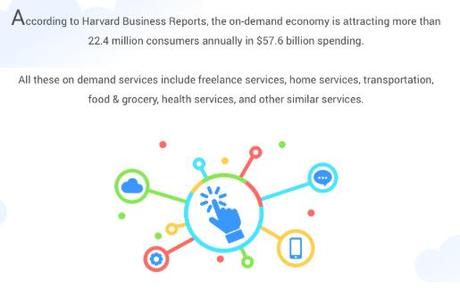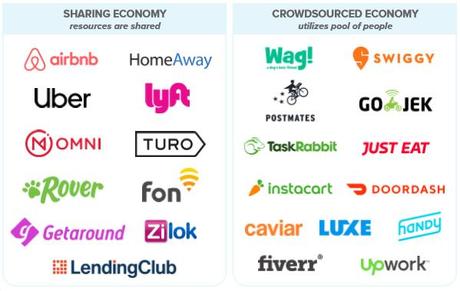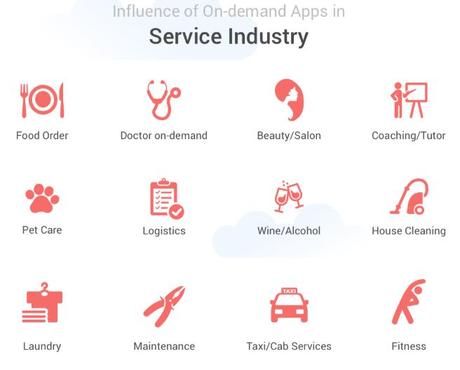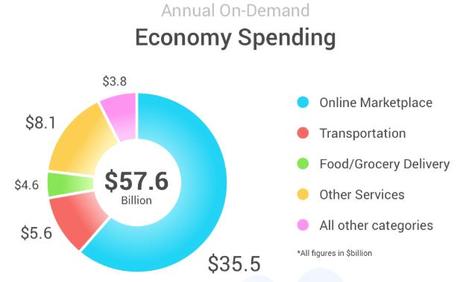5 total views, 5 views today
On Demand Apps are in which technology connects a buyer and a seller seamlessly and efficiently.One person needs groceries delivered home and another is available to cater to his requirement. Someone wants a ride to the airport and there's somebody who will drive him/her there. Another wants their pet given a daily walk and there's someone who is accessible to fulfill that request.
The evolution of human interactions driven by the ubiquitous smartphone is lucidly evident with the birth of the on-demand services.
And one of the most captivating features' of the economics of on-demand services is the company from whom the consumer apparently buys the service - whether a ride to his office, a piping hot meal from a restaurant, or a walk for his pet - in fact, employs none.
None of these are truly 'service-for-hire' businesses, but rather complex logistics establishments, whose core focus is to connect providers to clients in return for a commission.
In principle, the genesis of on-demand services came into being due to the principle of economics named optimization. If a restaurant can, for example, produce more food than what can be served in a day, then it makes sense to find a feasible way to sell those meals to them who may not be there physically.
In a similar manner, individuals who have time on their hands can make a quick buck through moonlighting that would further their earnings thereby maximizing the earning capacity of each individual in the marketplace.

On Demand Apps Business Model
Sharing Economy, Crowdsourced Economy, Gig Economy
The sharing economy is commonly built on top of the concepts of the on-demand economy, but not vice-versa.
In the sharing economy, resources are shared. If my parking is not being used, my bicycle not ridden, my PC sitting idle, or my cabin in the woods lying vacant, then these could be rented out to someone for a fee. Airbnb, GetAround, Quick-Ride, Lending Club, Lyft, Burro, are all examples of the sharing economy.

The crowdsourced economy is similar to the sharing economy, but here we are dealing with labor and not the resources.
Also Read: Package Delivery AppsThe crowdsourced economy utilizes the abilities, skills, and tangible resources of a group of people to deliver a service or product. Gig Economy alternatively used as Crowdsourced economy is driven by free workers who can work as much or as little as they want. Postmates, Swiggy, Roadie, Instacart, and UpWork are all examples of the crowdsourced economy.
These are built as on-demand companies, where users can easily and quickly request a service, a product, some information, and it's handled from start to finish through the on-demand ecosystem.
Stages to On-Demand Economy
One of the principal developments in the foray of the Internet in everyday life was to remove the physical middleman and this role is now taken over by technology. What really occurred is, the physical middlemen were not efficient and they had their limits. But now technology has taken up that role, which is amazingly efficient and scalable.
There are 3 stages in the on-demand economy.
1. Listing: To make aware the populace of what you have on offer.
2. Communication: To connect a consumer and provider. To book a service.
3. Payment: The service entails the transfer of revenue. To collect the consumer's money, and disburse it to the provider after deducting a fee.
As a consumer, it is worthwhile to remember that the on-demand service itself is truly the connecting entity. Whose value is determined by the efficiency, effectiveness, and its ability to source outstanding independent providers? Realtime connections are very much evident here. On-demand only works when connections between consumers and providers are instantaneous.

The defining component of success here will be the judgment by consumers that none else can do the work better in locating the right service provider at the right time. By description, no on-demand service can completely monopolize a provider community. Therefore they must continually strive to outperform their own competition.
Pricing will enter the fray, while today's reality is that the defining competitive advantage lies in convenience and timeliness. Consumers will flock the solution that speedily solves their concern. Providers will congregate to the service that in all probability will deliver a steady count of consumers.
The technological trend shaping that growth is realtime. Driven by low-latency, highly reliable connect, realtime is the adhesive that holds it all together. Delivering the instant gratification patrons long for, the instantaneous updates from the second the order is placed to its fulfillment.
And finally getting what we want as quickly as possible is what the show is all about. Like the on-demand video and SaaS products, the on-demand economy is built on the notion of not waiting. But getting what you want and when you want it. And realtime is the tech that ensures it.
Also Read: Mobile App Development Check-ListWhat is Real-time Computing
The concept of realtime is something that functions in what is perceived as immediate or in the moment. But in the on-demand economy, the truth is the service will not be fulfilled in realtime, yet, every step of the process - updates, tracking, the geo-location on a map, final payment - are all delivered in realtime.
What really makes realtime, real? You need a system (infrastructure) to deliver all data in realtime, and you need necessary protocols and APIs to build-up the functionality.
There are ways to do this.You can route the open-source way, spinning up your own infrastructure, utilizing open-source protocols like WebSockets (RFC 6455) or HTTP long-polling.
Or you can utilize a realtime service provider, that handles the entire infrastructure and provides you realtime APIs and SDKs (Max OS X) to do it.
Scalability is the major factor in this technological decision.As the on-demand economy continues to boom, user expectations rise. People are not just looking for quick service or delivery, but are looking for all the updates, alerts, notifications, and communication from start to finish.
It's a stream of constant updates and conversation, and the expectation (or, really, the requirement) is that everything happens in realtime.
The growth in user expectations means that on-demand applications are growing exponentially more data-intensive. Location tracking, chat messages, live updates, and more: on-demand services are creating, sending, and consuming massive amounts of data around the clock. And that creates a significant challenge for on-demand businesses: scaling.
What Is App Scalability
Scaling is ensuring that your app, service, or product preserves and continues reliable performance as your audience grows, base size increases, geographical location varies, and patterns of use change.
On Demand Apps that do not scale efficiently are forced to deal with repeated outages, security concerns, slow updates, and inconsistency in connectivity - which lead to disappointed, angry, and unhappy clients who may desert you. Because on-demand apps rely heavily on a fast, realtime experience, a failure to scale can be very apparent and deciding in the UX (user experience). Variations in efficacy and performance are easy to spot and incredibly frustrating to users.
When venturing to build on-demand apps, the scale is usually not on the list of 'Minimum Viable Product' (MVP). You are in fact focused on getting live quickly, acquiring users, reckoning your resource sharing strategy, thinking about live features you want to deliver through your application, and other salient features that will make your offering unique.
But as your application grows viral, due to heightened usage tragedy strikes. That's because an immense amount of planning and technology goes into building realtime, interactive, and data-intensive features that can operate flawlessly at scale.
As with several technological decisions, on-demand businesses find themselves in a position to make a build vs. buy decision: which is, in reality, a wide-spectrum decision rather than an in-and-out decision. How much of that infrastructure do you want to build and manage yourself, and how much you want to outsource to hosted-services and vendors?
Features to build & consider prior to deploying a scalable infrastructure for on demand apps.
- Synchronizing and positioning multiple testing, presenting, and production environments.
- Handling provisioning for those multiple environs (eg. straight-up rack-and-stack, Helios, Kubernetes containers, Docker Platform, etc.,).
- Installing your application code to given environs.
- Data replication at multiple points of presence. Automatic failover to enable messages are delivered every time (actually in realtime).
- Message 'catch-up' in case of connection dropout (when the delivery-person is in a tunnel, the customer must receive the message when he comes out).
- Setting service management, system checking, and alerts.
- Create a load balancing scheme like Nginx or Apache or HAProxy.
- Implement a scheme to segment data (by channels/topics).
- Find a store-and-forward solution like in-memory caching for signal recovery.
- Implement a method to connect a client to an ideal data center/port (eg. global server load balancing and intelligent traffic management).
- Figuring the channel, subject to send or receive for a client.
- Building synergy between data centers and cloud regions so as to ensure data reliability between endpoints.
- Decide which platforms and languages to support. (To launch any other version).
- Creating universal data serialization.
- Customizing code to detect a data uplink which can work across devices.
- Determine the quality of service, level of loss margins, and develop a data recovery system.
- Load testing service to simulate genuine users (maybe custom-built).
- Create an update protocol to continuously modify the network to support new products or services.
- Paying for necessary costs such as Socket server costs, hot failover & QA systems.
- Build a load distribution system.
- Identify error messages.
- Develop a playbook of responses when faults occur.
- Building service management (like Cabot, PagerDuty, OpsGenie).
- Develop a multi-datacenter deployment.
The list is not exhaustive, of course, there's a lot to do.
Massive amounts of technology and expertise go into designing, deploying, and organizing scalable on demand apps. It is challenging to design it from scratch, especially with a humongous number of synchronous users. To do it well, expertise in DevOps, process-based tech (CGI), server-side technologies, thread-based tech (JSP) and much more, is essential. An attractive front-end has its limits.
There is always a possibility to deliver success as long as hosted services provide reliable and scalable infrastructure. This will in turn help relieve you the stress and accountability of delivering a seamless, reliable on-demand experience your loyal consumers will mandate to remain devoted.

Conclusion Building On Demand Apps
On demand apps will go heavy on data-intensive approach as many more sources of data stream updates, and new ways of communication are launched. Therefore adopting favorable technologies and infrastructure is imperative. Only those who utilize and deliver the correct data at the right time will have the clout in providing the industry winning user experience.


